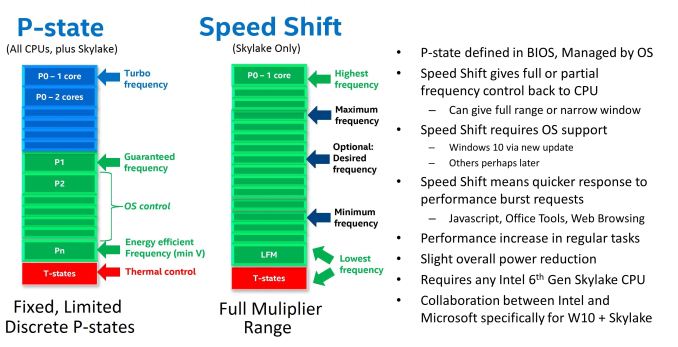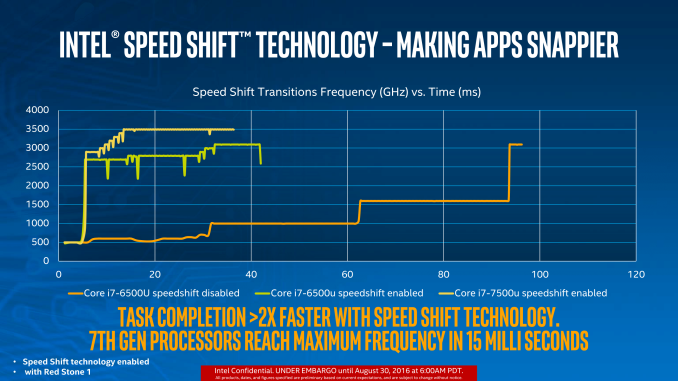The Intel Core i3-7350K (60W) Review: Almost a Core i7-2600K
by Ian Cutress on February 3, 2017 8:00 AM EST7th Generation New Features
One of the big questions regarding the launch of Intel’s 7th Generation of CPUs was around what extra features the new platform brings, especially if there isn’t any clock-for-clock performance improvement. As with our other Kaby Lake reviews, here we explain the main two: Speed Shift v2 and Optane Memory support.
Speed Shift v2
For the Intel’s 6th Generation of processors, Skylake, they introduced Speed Shift (v1). This was a feature that, at a high level, gave control of the voltage/frequency curve from the operating system to the processor. Using a series of internal metrics, such as instruction analysis and frequency, the CPU would automatically adjust the voltage and frequency of the processor as required. This afforded two major benefits: one, with the CPU in control it has access to many more points on the curve compared to the OS which is limited to specific P-states on the processor.
The second benefit is the speed of transition. A processor that can ramp up to a high frequency quickly and then drop down as needed can get through instructions quicker but also save power. Imagine driving a car, and having to wait 60 seconds to change a gear – it’s that sort of analogy.
What Speed Shift v2 does in the Kaby Lake family, compared to v1 in Skylake, is manage those transitions to higher frequency faster. Before Speed Shift, transitions from idle to peak turbo were on the order of 100 milliseconds, and Speed Shift v1 took that to 30 milliseconds (with a good base established within 15). Speed Shift v2 means that peak performance from idle now happens in 10-15 milliseconds total. This means that interactions with the OS, such as touch, or actions that rely on low latency, can occur within a couple of frames on a 60 Hz display.
The benefit of Speed Shift lies a lot in touch devices, which perhaps doesn’t affect the desktop Kaby Lake processors in this review, but also in web interactions. A lot of web work is stop and start, such as scrolling or javascript functions.
There is one caveat however – Speed Shift currently only works in Windows 10. It requires a driver which is automatically in the OS (v2 doesn’t need a new driver, it’s more a hardware update), but this limitation does mean that Linux and macOS do not benefit from it. I would be hard pressed to not imagine that Apple and Intel were not working on a macOS driver, but as yet we have not had confirmation that one exists.
Optane Memory Support
The latest memory technology to hit prime time is Intel and Micron’s 3D XPoint. This is a non-volatile form of data storage that is bit addressable and can be used as DRAM or storage. Despite being at least a decade in the making, and being formally announced in 2014, it is still yet to show up commercially as it is still being developed. Intel plans to create 3D XPoint DRAM that is slightly slower than normal DRAM but both denser (more of it) and non-volatile (keeps the data after power loss, saves power altogether), as well as 3D XPoint Storage that is faster than standard NAND flash, and more configurable. It the scheme of things, we expect the storage based products to hit the market first.
Intel, as far as we can tell, is set to release two main classes of product: Optane DRAM to be pin-compatible with DDR4 and require Optane DRAM enabled processors, and Optane SSDs which should work with any PCIe storage interface. ‘Optane Memory’ however, is something a little different. Based on pre-briefings, Optane Memory is certainly not Optane SSD we were told, but rather a storage cache for mechanical hard-drives. We’ve had this before with NAND flash drives, using Intel’s Rapid Storage Technology, and it seems that Kaby Lake and 200-series chipsets will support a new version of RST for PCIe based storage. But because this is caching drive, such as the 16GB Optane Memory drives in Lenovo’s upcoming notebooks, and not Optane SSD, might lead us to believe that ‘Optane Memory’ drives are not designed to be directly user addressable.
All that being said, Intel has stated that Optane Memory standalone drives should hit the market nearer Q3 for general consumer use, which is more in-line with what we might expect to see with Optane SSDs in the enterprise space.













186 Comments
View All Comments
allanmac - Friday, February 3, 2017 - link
G4600T HD 610 ⬅ TYPO: HD 630G4560 HD 630 ⬅ TYPO: HD 610
Ian Cutress - Friday, February 3, 2017 - link
Updated :)KLC - Friday, February 3, 2017 - link
I have an 8+ year old Q6600 desktop and am thinking about a new build. I do mostly office work and photography with Adobe Lightroom and Photoshop, no gaming at all, I'll use the integrated graphics. Both LR and PS seem to not utilize multiple cores very well and respond mostly to clock speed. I'm wondering if my best bet is to buy one of these i3K cpus and mildly overclock. I will get the highest clock speed at a price lower than an i5K or i7K. What do you think?t.s - Friday, February 3, 2017 - link
Me: $168 is way to overpriced. I'll get i3 7100. Or go with i5 7500.KLC - Friday, February 3, 2017 - link
i3 7100 is not a bad alternative. Like I said, most photography oriented tests show LR and PS to perform better with just a higher clock speed, not to multiple cores or anything else. With this cpu with a mild overclock up to say 4.5ghz I'm faster than an i7 clock for hundreds less. I'm wondering if that is worth $50 over the 7100. I'm thinking it is, $50 more factored into a complete new build is not much. Thanks for the comments.CaedenV - Friday, February 3, 2017 - link
Dude... you are coming from a Core2Quad. Even the weakest i3 is going to blow your mind!Seriously though; the CPU you buy essentially does not matter. If you are running on the iGPU then just get a chip with the best iGPU you can afford and call it a day. Pair it with a SSD (does not even need to be NVMe), and you will be absolutely blown away with the performance gains!
You should probably look at a simi-custom build like an Intel NUC, or Brix, or other such system where you just add ram, SSD, and OS. There is little to no point in building a whole tower PC unless you are doing something heftier than lightroom.
For that matter, look into a laptop with a decent dock. You can do most of your work in the field while taking pictures, and dock it to a nice color correct screen for the fine-tuning end of work.
Elsote - Friday, February 3, 2017 - link
"just get a chip with the best iGPU you can afford"Are you talking about AMD?
Michael Bay - Saturday, February 4, 2017 - link
He said "best", not "the only reason anybody will even look at this case heater".Iris Pro.
KLC - Friday, February 3, 2017 - link
Oh, I know anything I build will be a big step up from what I have. I am going for a desktop but probably a mini ITX mb maybe in a nice Lian Li case, definitely an SSD. I'm still thinking about the details.fanofanand - Friday, February 3, 2017 - link
I am still on a Q6600 at home and a Skylake CPU at work. The difference isn't as "mind blowing" as some would suggest. It depends on what you do, and yes things that are IPC dependent will be much faster on newer systems, but the Q6600 is still no slouch.